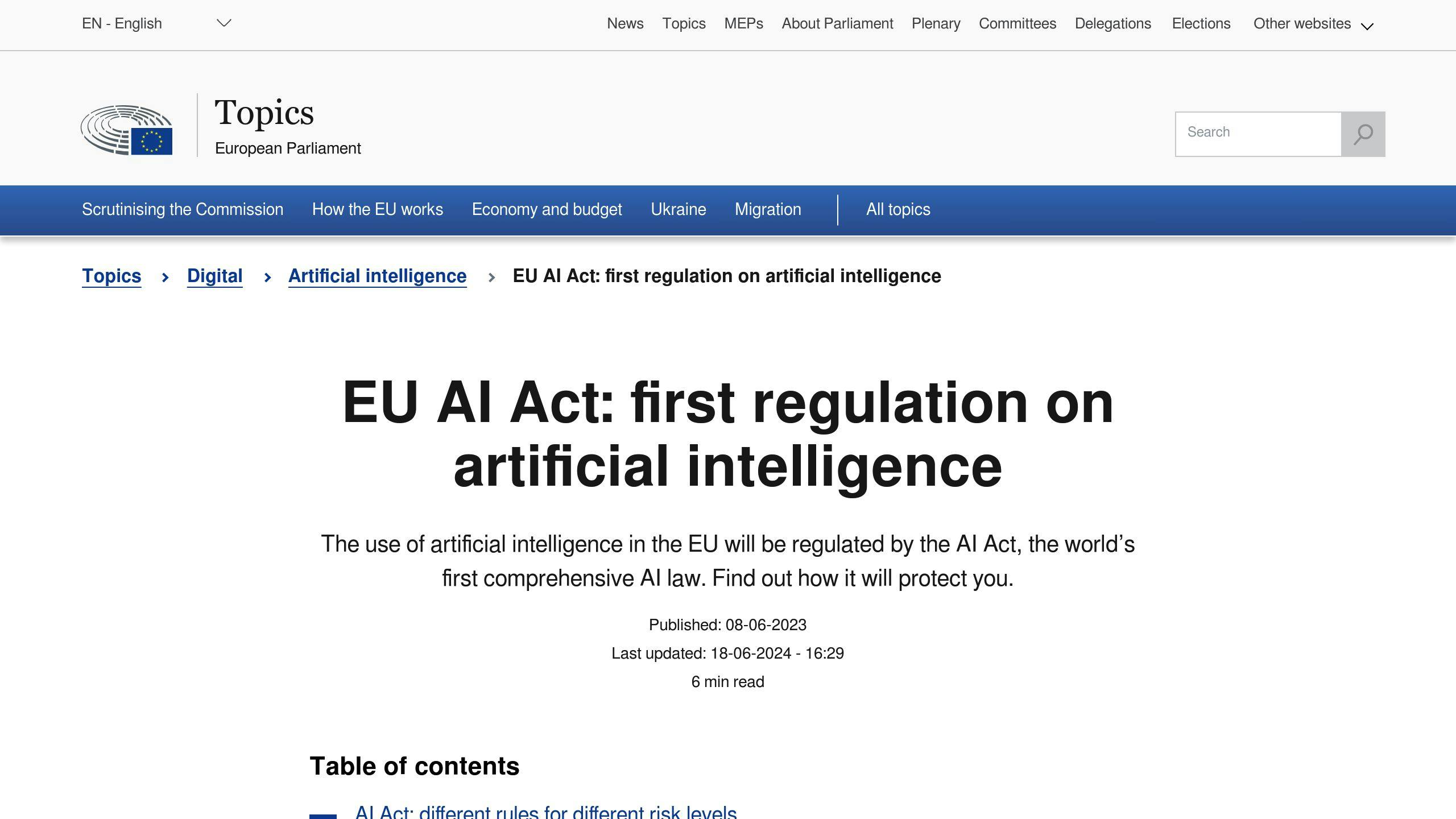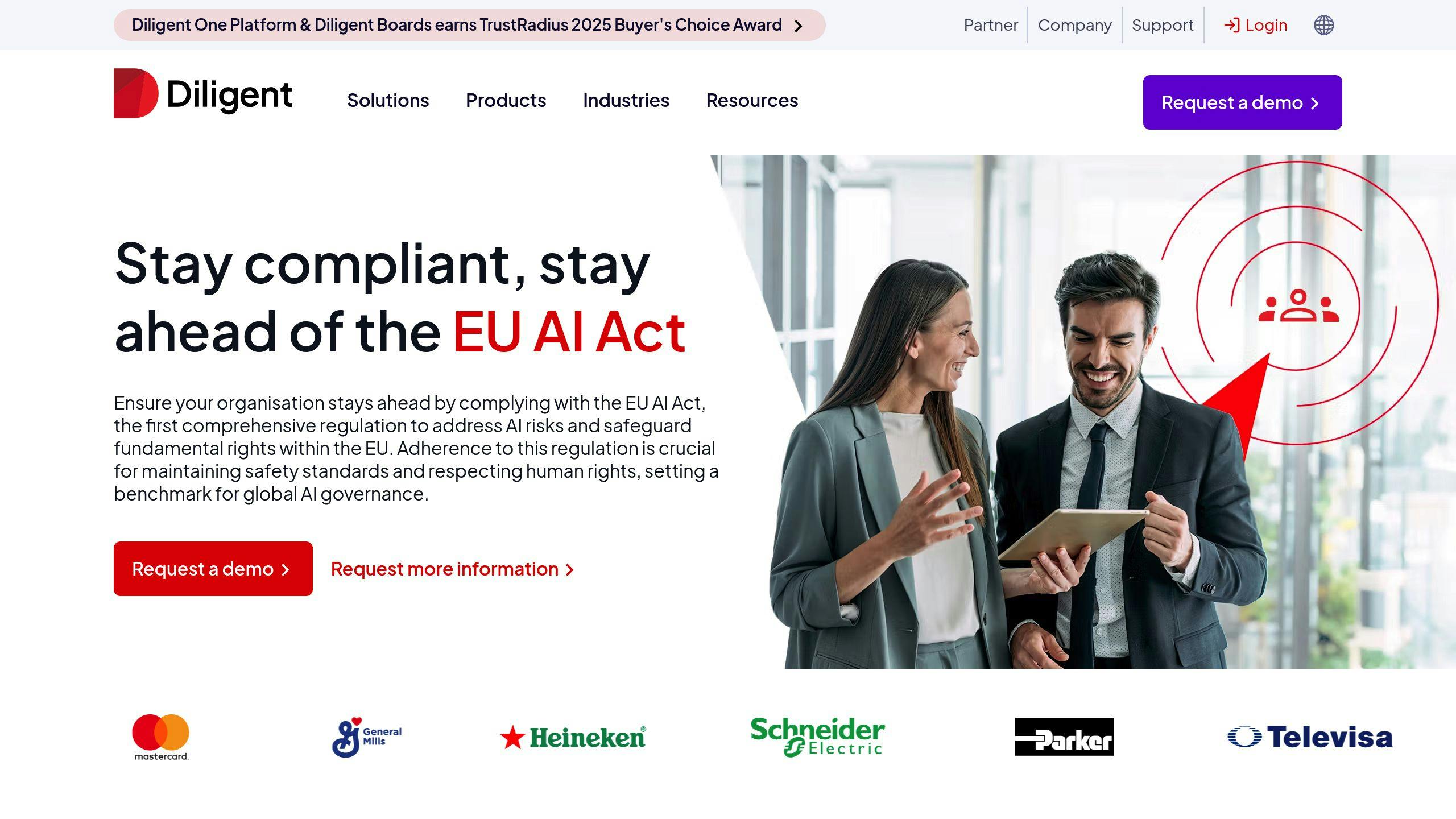The EU AI Act is a strict regulatory framework for AI systems, classifying them into four risk categories: unacceptable, high, limited, and minimal. Non-compliance can result in penalties of up to €35 million or 7% of global turnover. Compliance tools are essential to simplify and automate adherence to these rules, especially for high-risk systems.
Key Takeaways:
- Compliance Tools: Automate risk assessment, documentation, monitoring, and team collaboration.
- Popular Tools:
- PwC AI Compliance Tool: Real-time risk monitoring, automated documentation, and audit support.
- EU AI Act Compliance Checker: Risk classification and tailored compliance guidance.
- Diligent AI Act Toolkits: AI system discovery, risk classification, and centralized documentation.
- Steps for Effective Compliance:
- Build an AI system inventory.
- Use automated risk assessment tools.
- Establish cross-functional compliance teams.
- Regularly monitor and update compliance processes.
Quick Comparison:
| Tool | Key Features | Best For |
|---|---|---|
| PwC AI Compliance Tool | Real-time monitoring, audit tools | High-risk systems, audits |
| EU AI Act Compliance Checker | Risk classification, compliance guidance | SMEs, cost-efficient solutions |
| Diligent AI Act Toolkits | AI system discovery, centralized records | Comprehensive documentation |
Related video from YouTube
Key Compliance Tools for the EU AI Act

Features of Diligent AI Act Toolkits

Diligent AI Act Toolkits focus on three main tasks: AI system discovery, risk classification, and compliance management. These tools help organizations catalog their AI systems, assess risks automatically, and manage compliance documentation - all from a single platform.
| Feature | Function and Benefit |
|---|---|
| AI Discovery | Automates the identification of AI systems, ensuring nothing is missed |
| Risk Classification Engine | Evaluates risk levels based on EU AI Act rules, cutting assessment time by 60% |
| Compliance Documentation | Centralizes records and audit trails for easier reporting |
While Diligent AI Act Toolkits excel in system discovery and risk assessment, PwC's AI Compliance Tool offers a broader range of features, including operational and audit support.
Capabilities of PwC AI Compliance Tool

PwC's AI Compliance Tool is designed to handle risk assessment and audit processes with precision. It combines technical evaluations with business-oriented compliance strategies, making it easier for organizations to meet both operational and regulatory demands.
"Achieving compliance with the proposed AI Act will necessitate a comprehensive and coordinated effort across the organisation and technical domains." - PwC Czech Republic
Key features of the tool include:
- Real-time risk detection and monitoring
- Automated compliance documentation
- Customized guidance for both technical and business teams
- Built-in audit support tools
Using the EU AI Act Compliance Checker
The EU AI Act Compliance Checker is an interactive tool tailored for organizations, especially SMEs, to evaluate their AI systems against the Act's requirements. It simplifies the risk assessment process and provides cost-efficient compliance solutions.
The Compliance Checker helps by:
- System Classification: Identifying whether an AI system is covered under the Act
- Risk Assessment: Determining risk levels and related responsibilities
- Compliance Guidance: Offering specific recommendations based on system type
For high-risk AI systems, where penalties can reach €15 million or 3% of annual turnover, tools like these are essential. Regulatory sandboxes - controlled environments for testing compliance strategies - can help organizations implement these solutions effectively.
AI Governance Platforms
FairNow's AI Governance Platform adds another layer to compliance efforts. It supports ongoing management by ensuring transparency and fairness in AI usage through continuous monitoring and testing. This helps organizations stay aligned with regulatory standards over time.
Steps to Use Compliance Tools Effectively
Building an AI System Inventory
Creating an AI system inventory helps organizations stay on top of compliance risks by offering a clear overview of all AI systems in use. Tools like FairNow's AI Inventory feature can help document and categorize these systems based on their purpose, data sources, and potential risks.
When building this inventory, make sure to include key details like the system's name, version, and deployment date. Also, track risk factors such as data types, automation levels, and scope of impact. Don't forget to list any dependencies, like third-party components or APIs, and gather essential documentation like technical specs and training data sources. This level of detail not only ensures visibility but also supports audit preparation.
Establishing Risk Management Processes
Managing risks effectively means setting up structured processes that align with the EU AI Act's standards. Organizations should focus on ongoing monitoring and evaluation of AI systems throughout their lifecycle.
A solid risk management framework should cover three main areas:
- Risk Assessment Tools: Use automated tools to classify risks based on the Act's criteria. This can cut assessment time significantly, making the process more efficient.
- Recordkeeping: Platforms like PwC's AI Compliance Tool can help maintain detailed records of risk evaluations, mitigation efforts, and compliance activities.
- Team Collaboration: Ensure legal, technical, and business teams are on the same page by establishing strong communication channels for risk oversight.
To keep these processes effective, organizations can rely on AI governance platforms for continuous compliance tracking.
Leveraging AI Governance Platforms
AI governance platforms play a key role in meeting compliance requirements, especially under the EU AI Act. These tools streamline the process of monitoring, documenting, and ensuring transparency.
Key features of these platforms include:
- Real-time Monitoring and Workflows: These tools help track system performance, flag risks, and guide teams through compliance steps automatically.
- Automated Documentation: High-risk AI systems require extensive documentation, and these platforms can generate and maintain the necessary records. This is crucial, as non-compliance penalties can be as high as €35 million or 7% of annual revenue.
sbb-itb-9890dba
Planning for Long-Term Compliance
Building Compliance Teams
FairNow highlights that successful compliance teams bring together experts from legal, IT, and business fields. This mix ensures a well-rounded approach where technical risks are managed, legal obligations are met, and business goals remain on track.
In this setup, technical specialists focus on system monitoring, legal professionals ensure adherence to regulations, and business leaders maintain operational efficiency. This collaborative structure allows organizations to adapt swiftly to regulatory updates without disrupting productivity.
Monitoring and Updating Compliance Processes
Keeping compliance processes up to date is essential to meet the changing requirements of the EU AI Act. Tools like PwC's AI Compliance Tool offer a structured way to monitor compliance, recommending regular reviews to stay on top of obligations.
Best practices include monthly updates to system documentation, quarterly risk assessments, and semi-annual conformity audits. While these steps are crucial for high-risk AI systems, even low-risk systems can benefit from adopting similar practices to stay ahead of potential regulatory shifts.
Voluntary Compliance for Low-Risk AI
For AI systems classified as low-risk, voluntary compliance measures can still offer major advantages. The EU AI Act promotes voluntary codes of conduct, which not only build trust but also help organizations prepare for future regulations.
Focusing on transparency and thorough documentation is key for voluntary compliance. This approach showcases a commitment to ethical AI practices and reduces the challenges of meeting future requirements. By establishing strong compliance processes early on, organizations can minimize risks while developing AI systems that inspire greater trust and reliability.
Conclusion and Looking Ahead
Key Takeaways
The EU AI Act has reshaped how organizations develop and deploy AI systems. Tools like PwC's AI Compliance Tool and the EU AI Act Compliance Checker have become essential for managing risks and meeting regulatory requirements. These tools offer structured methods for assessment and management, helping organizations stay aligned with the law. Importantly, they need to handle regulatory updates efficiently without disrupting operations. The financial risks of non-compliance are high, making it critical to have strong compliance strategies and the right tools in place.
"The integration of compliance tools isn't just about meeting regulatory requirements - it's about building sustainable AI governance frameworks that can adapt to evolving standards while maintaining operational efficiency."
By using these tools effectively, businesses can address current regulations and prepare for future changes.
Getting Ready for Future AI Regulations
As regulations evolve, businesses must stay ahead by adapting their strategies and leveraging the groundwork laid by compliance tools. The EU has taken steps to support accessibility, such as offering regulatory sandboxes and reduced fees for SMEs. However, organizations should focus on proactive measures to stay compliant.
To tackle future challenges, companies need scalable governance systems that can adjust to new regulatory demands. Key actions include conducting regular risk assessments with automated tools, maintaining centralized inventories of AI systems, and ensuring cross-functional teams are ready to adapt to new requirements.
Compliance tools should provide real-time monitoring and update capabilities to remain effective. Organizations that integrate these tools into flexible compliance frameworks will be better equipped to navigate the ever-changing AI regulatory environment.
FAQs
What are the logging requirements for the EU AI Act?
The EU AI Act emphasizes maintaining accountability and traceability for high-risk AI systems through detailed logging requirements. Organizations using these systems must keep automatically generated logs for at least six months, with possible extensions depending on applicable laws.
Here’s a breakdown of logging requirements by risk level and how compliance tools can assist:
| Risk Level | Logging Requirements | Compliance Tools Support |
|---|---|---|
| Unacceptable | Prohibited - N/A | System detection and blocking |
| High-Risk | Mandatory 6+ month retention | Automated logging and monitoring |
| Limited Risk | Voluntary logging | Basic tracking capabilities |
| Minimal Risk | No specific requirements | Optional monitoring features |
The EU AI Act uses a risk-based classification system, and tools like PwC's AI Compliance Tool simplify compliance by automating the logging process to meet these requirements.
"Automated logging is essential for responsible AI governance, ensuring transparency and accountability."
For organizations to meet these standards, compliance tools should offer features like:
- Tracking system behavior and decisions.
- Securely storing logs for the required period.
- Providing quick access for audits.
- Integrating with existing data governance systems.
To implement this effectively, companies should configure their tools to automatically capture and retain necessary logging data while applying strict access controls and data protection protocols.



